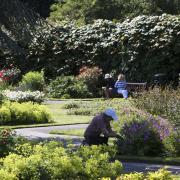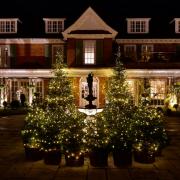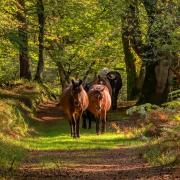As the world's most important collection of roses comes in to its 50th year, we head to Mottisfont to discover how its garden grows and what the team are doing now to protect it for the future
One of the most important collections in the world can be found in the walled garden at Mottisfont in Romsey, which is home to the national collection of pre-1900 shrub roses. Flowering just once a year, the roses reach their peak late May to mid-June and it is an extraordinary sight.
The garden was created in the 1970s by Graham Stuart Thomas – a leading figure in 20th-century British horticulture. He said of Mottisfont: ‘Few better sites could have been found for a garden of old roses than this.’
With an artist's eye and consummate knowledge, the horticulturist designed a garden that would combine roses with a mix of perennials, including campanula, foxgloves and hardy geraniums to give a season-long display. All set against the backdrop of ancient walls.

‘His plant knowledge was phenomenal,’ says senior gardener Michael Harvey. He collected these roses from across the world and created the rose garden we have today; a lot of these roses would have been lost forever.’
Michael describes the garden as ‘a paint box of many colours’. When I speak to him, he is in the garden with a chorus of birdsong competing with our conversation. ‘Unlike the modern roses of today, many of the historic roses only flower once a year. Mottisfont has the original roses that have been used by nurseries to cultivate other varieties. There are roses in this garden that you won’t find anywhere in Europe or across the world; some of these are so rare. If you were to smash a plate in your home, you can replicate it using a photograph, but if you were to lose a rose, you can't replace it because you can't get the genetics of that rose back. That's how important this collection is.’
However, caring for these rare plants can have its challenges and the roses tell their own story of how climate change is affecting the environment. ‘The issue with historic roses is because they only flower once and because of the heat that we get now, the blooms can go over very quickly, it's one of our biggest challenges. Because we are in a walled garden it poses more issues, you have the heat from the walls, the wet spells are causing all sorts of problems and plants are coming up early. One thing I am really noticing is pests and diseases which would not normally survive a cold winter are surviving as we are not having those cold spells like we used to.’

To combat this the garden team undertake soil testing to ensure soil health is at its best, apply organic mulch to retain moisture and have recently teamed up with the Tsegereda garden in Addis Abba, Ethiopia to share information; Michael will be travelling to Africa in September.
‘The National Trust are part of the International National Trusts Organisation (INTO). A worldwide organisation committed to protecting cultural and natural heritage globally. INTO were helping the Tsegereda garden in Addis Abba and suggested it twinned with Mottisfont and Hinton Ampner. It will allow us to share the global effects of climate change and what impact it is having in Ethiopia as well as the UK. We have both been sharing our knowledge with the Tsegereda garden team and feel that it is a good opportunity to go over to Ethiopia and work with the university. It’s going to be an eye-opening experience and will hopefully work well with the team in Addis.
The collection at Mottisfont contains over 400 varieties including ancient varieties Rosa Gallica Officinalis, a light crimson and deeply scented shrub brought to England from Persia by the Crusaders; the highly scented Quatre Saisons, an autumn damask which was grown by the Romans. And Rosa Souvenir de la Malmaison – a pale pink bourbon rose inspired by the Empress Josephine’s famous garden. Visitors to the garden can purchase the garden’s own award-winning rose. The Mottisfont, a fragrant hybrid tea rose with magenta coloured ‘nostalgia style’ blooms.

Michael’s favourite rose in the collection is Charles de Mills. 'The flower is absolutely fantastic. It is a gallica, very historic with purple reddish blooms. It looks like a flower that's been cut in half.’
Gardener Carolyn Sewell has worked in the rose garden for the past two years, after first volunteering and visiting it for over 25 years. ‘As you come through the gate, you are met with this beautiful display of the roses with their companion plants. The planting is very free, like a cottage garden. The roses are beautiful old forms with many petals; all quite different and special in their own way.’
The care of historic roses requires a bespoke approach she explains. Different varieties have their own pruning requirements - roses really like air, space and light. They don't like a whole lot of competition directly under where they are growing. They do all have their own individual characteristics. We have one called Ethel, that we love. She's in the walled garden, but also in the grounds where she's left been left to do her own thing and grown up a huge tree. In the walled garden it’s a battle to prune her. She gets caught in our hair, stuck on our coat. It’s like some of these roses take on the own personalities.’

Carolyn learnt gardening from her grandfather, a keen gardener. ‘My grandfather grew roses. He used to tell me what each one was called and I remember all the names. When I was at primary school, once a week I used to have lunch with my grandparents. My grandfather would pick me some roses for me to take back to school. Gardening has always been part of my life. It is a passion.
‘I think roses are popular because they're part of our heritage. They come from all over the northern hemisphere, but we've really made them our own. You can't have an English country garden without roses; it adds to the charm.’
One of the garden’s most Instagram-able areas is the bench seating. ‘Looking down a tunnel of roses at the end we have a bench with a pink rose growing over it. The rose is named Constance Spry. She is an interesting person from history; she was a home guru and advocated mixed flower arrangements which was avant-garde at the time. She did the flowers for Queen Elizabeth II’s Wedding and Coronation.’

Mottisfont is the only publicly open garden where people can view some of the rarer rose varieties, which are not available commercially. ‘We want to highlight that it’s an important collection but also a special place,' says Carolyn. 'A lot of our visitors come on their own. They come for time to themselves to evoke a memory or on special occasions. There’s a real sense of calm.’
As the proverb says, ‘Take time to smell the roses.’
The gardens will be open until 8pm on Thursdays to Saturdays between May 30 and June 29. Rose garden celebration evenings run on June 7, 14 and 21 with free live jazz, plus wine tasting from Hampshire vineyard Black Chalk



























